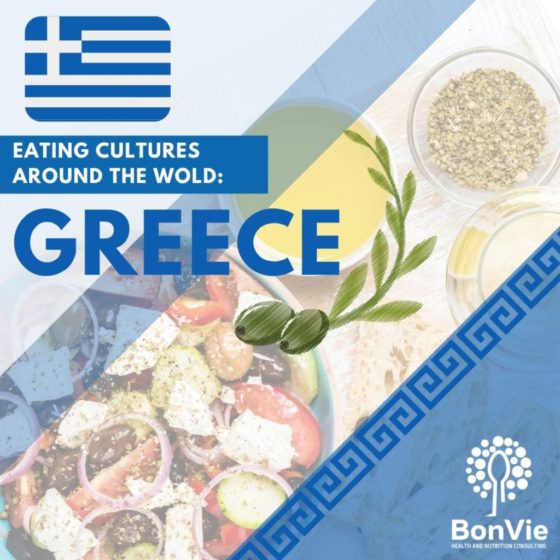
22 Jan Eating Cultures Around the World: Greece
The Greek have a worldwide reputation as having one of the healthiest food cultures and diets. It is not surprising, then, that the “Mediterranean diet” emerged from Greek food culture as a common diet trend. Many continue to adhere to this diet in an attempt to lose weight, prevent chronic disease, and live longer lives – it has been promoted by doctors, public health practitioners, and nutrition specialists for decades – and for good reasons!
The Greek diet includes large amounts for plant-based foods and healthy fats, which makes their diet different from what we usually perceive as “healthy”. Fats, in general, have received a bad reputation in America, mainly due to the emergence of the obesity epidemic (which some have attributed to our increased consumption of fats – though that’s really because of the types of unhealthy fats so many of us consume – a topic for another blog). On the flip-side, the Greeks have included large quantities of healthy fats in their diets for generations and have only shown proof of longevity and health from these diet choices.
Greeks once had one of the highest life expectancies and lowest chronic disease rates of any country. Like most other developed countries, the obesity epidemic is beginning to catch up to Greece. Many dietary habits have changed in recent years, as Greeks have started to adopt a more westernized way of living and eating. Processed foods, fasts foods, and take out foods have become common in recent years.
Greeks typically eat three meals a day, with the largest meal being lunch.
Proino (breakfast) is usually small, including staples like herbal tea, soft boiled eggs and bread. Paximadi (dried bread) is also very common for breakfast, and often paired with cereal, yogurt, honey, jams and jams. Kolatsio (mid-morning snacks) typically include cheese or spinach pies, and ham and grilled cheese sandwiches.
Many Greeks skip breakfast and just eat their mid-morning snack around 11am. Many Americans do this, too, right? Intermittent fasting, anyone?
Mesimeriano (lunch) has been traditionally enjoyed at home with family, with all family members leaving school and work to come home for this meal. Today, some employers will not allow employees to go home for lunch, but all schools in Greece will! Lunch can last for hours and include food items like vegetable casseroles, stews, legumes, salads, feta and other cheeses, bread, tomatoes, olives, greens and cheese pies and wine. Afternoon coffee is common in Greece as well.
Vradino (dinner) is usually pretty late by American standards (around 9 to 10pm) for many traditionalists – which isn’t surprising, given the mid-day feast they enjoy for lunch. It may be something as small as yogurt, fruit, honey and a sandwich. However, younger generations of Greeks are starting to eat their main meals around our American dinner time instead.
Regardless of when they eat, it’s what they eat that makes Greek food so fantastic! Lots of fresh fruits and vegetables, healthy fats galore, and delicious cheeses, too! Sign me up for that! My husband can’t stand that I say it every time I sprinkle feta on a salad, but I swear my catch phrase is true and will catch on someday: “Feta just makes it betta!”


No Comments